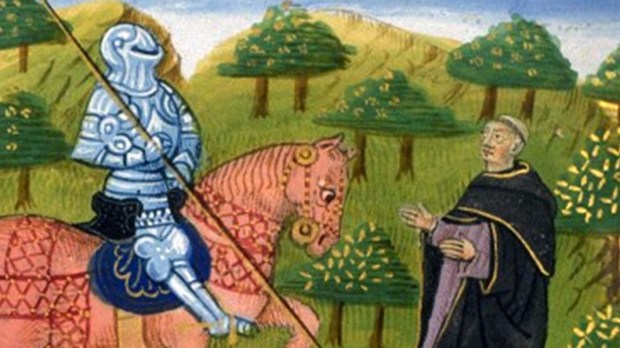In the Middles Ages, Advent took on a special meaning as a time awaiting the Prince of Peace.
Beginning in the 10th century, a peace movement with names such as the “Peace of God” and the “Truce of God” was designed to abolish violence and private warfare and guarantee protection to pilgrims and travelers, according to the Encyclopaedia Britannica.
The Peace of God was first declared in 989 at a council held at Charroux, France, the encyclopedia says. The agreement “prohibited men from entering churches by force or plundering them, forbade the usurpation of a peasant’s property, and upheld the rights of noncombatants.”
The Truce of God appeared somewhat later, around the year 1027, as an addition to the Peace of God. It “provided for periodic armistices between feuding parties, suspending private wars from Wednesday night to Monday morning in remembrance of Christ’s sufferings. Bishops gathered the members of their dioceses together, commanded them to pledge an oath to keep the peace, and imposed spiritual penalties on those who refused.”
Peace was required throughout Advent, the season of Lent, and from the beginning of the Rogation days until eight days after Pentecost, according to William Ward Watkin, in a paper published in 1942.
After the failure of the last Carolingian rulers to keep order in West Frankland, and the accession of Hugh Capet, founder of a new dynasty in 987, independent warlords began appearing. Peace assemblies were one way to deal with the disorder.
“Typically, these councils were held in large open fields around exceptional gatherings of saints’ relics, brought from the surrounding regions. Each relic brought with it a throng of faithful,” according to Boston University history professor Richard Landes. “In the presence of the large crowds of commoners attracted by these relics, the elders of the council (dukes, counts, bishops, abbots) would proclaim Peace legislation designed to protect civilians (unarmed churchmen, peasants, merchants, pilgrims) and control the behavior of warriors. Often the warriors would swear an oath on the relics in the presence of all assembled.”
Though the Peace of God and Truce of God survived in some form until at least the 13th century, they were not too effective.
“Traditionally, historians have dismissed the Peace of God as an interesting failure, a movement which only briefly occupied an important place on the historical stage,” Landes writes. “In trying to control warfare without the use of physical coercion it rapidly foundered on the rocks of a violent feudal reality.”
Landes points out that the lack of a coercive power to enforce the peace “may have been precisely what made the Peace of God so influential.”
For without recourse to force, it had to depend on more fundamental cultural activity: building a wide and powerful social consensus, developing courts of mediation, educating a lay populace, high and low, to internalize peaceful values. In this sense, the Peace movement laid the groundwork for later developments:
- it awakened the populace, both rural and urban, to the possibilities of self-organization; producing a wide range of “textual communities” or laboratories of social experimentation structured around a text (law).
- it helped to “Christianize” the nobility, encouraging the development of chivalry
- it gave enormous authority to the Church, which, having mediated the Peace, became a major “player” in the political and social organization of lay society
- and it opened up an often fervent, if occasionally tragic, dialogue between cleric and layman on the true meaning of Christianity.

